PPMP20009: Leading Lean Projects - Building Dream Home Project Report
VerifiedAdded on 2022/12/01
|11
|3836
|86
Report
AI Summary
This report details the application of lean project management principles, specifically utilizing the PMBOK framework, to the construction of a dream home. It begins by outlining the project's initiation, planning, execution, monitoring, and closing phases, including the selection of a suburb in Perth, Western Australia, and determining the land size. The report then delves into the selection of a builder, emphasizing stakeholder identification and the factors influencing the design and layout of the home, such as trends, accessibility, sustainability, and local regulations. The design phase utilizes PMBOK for data analysis and design selection. The report concludes by highlighting the project's reliance on stakeholders, including the project manager, architects, suppliers, and contractors, and how their roles contribute to the successful execution of the project. The report provides a comprehensive overview of how lean project management can be implemented in the building of a dream home, from initial planning to final design approval.
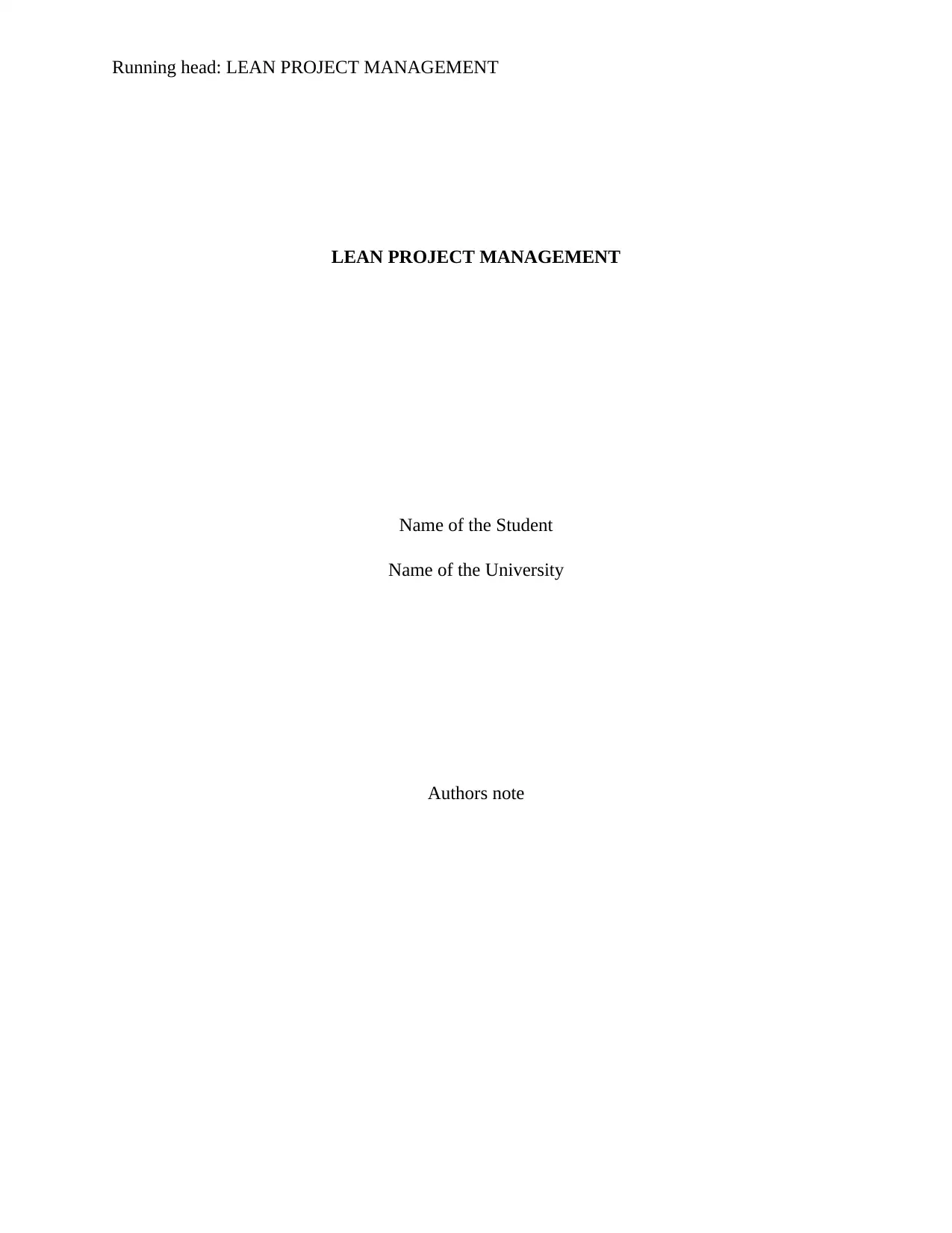
Running head: LEAN PROJECT MANAGEMENT
LEAN PROJECT MANAGEMENT
Name of the Student
Name of the University
Authors note
LEAN PROJECT MANAGEMENT
Name of the Student
Name of the University
Authors note
Paraphrase This Document
Need a fresh take? Get an instant paraphrase of this document with our AI Paraphraser
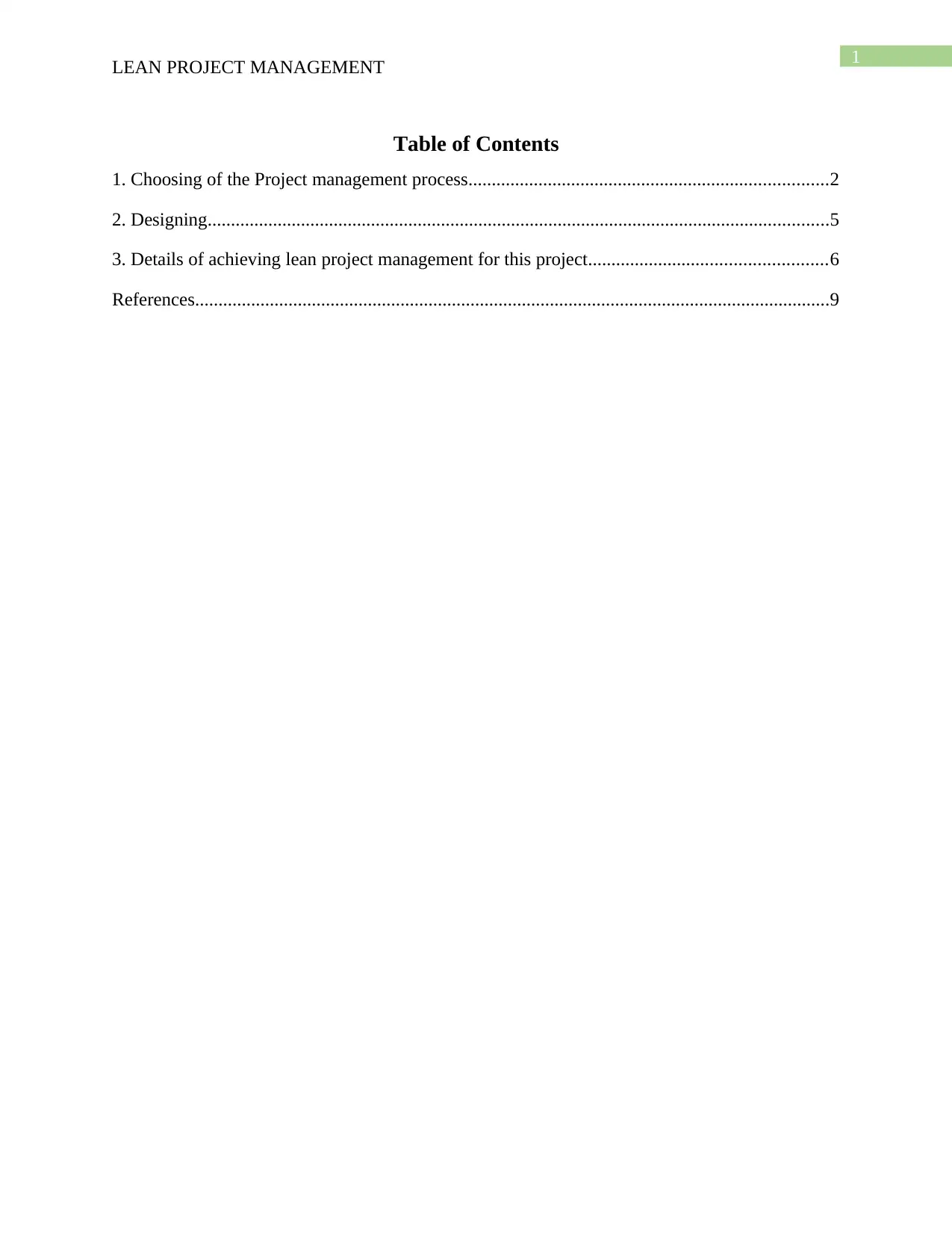
1
LEAN PROJECT MANAGEMENT
Table of Contents
1. Choosing of the Project management process.............................................................................2
2. Designing.....................................................................................................................................5
3. Details of achieving lean project management for this project...................................................6
References........................................................................................................................................9
LEAN PROJECT MANAGEMENT
Table of Contents
1. Choosing of the Project management process.............................................................................2
2. Designing.....................................................................................................................................5
3. Details of achieving lean project management for this project...................................................6
References........................................................................................................................................9
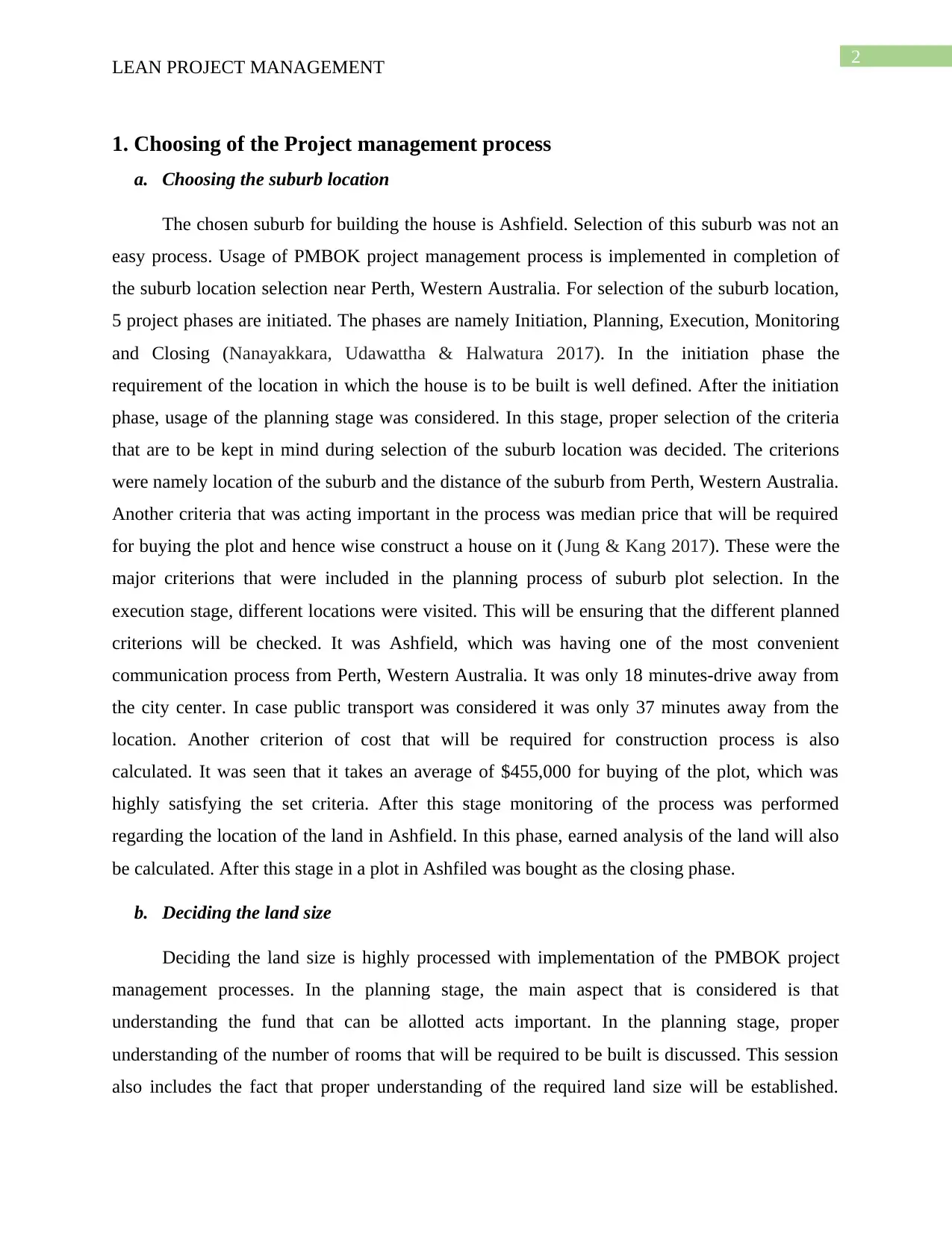
2
LEAN PROJECT MANAGEMENT
1. Choosing of the Project management process
a. Choosing the suburb location
The chosen suburb for building the house is Ashfield. Selection of this suburb was not an
easy process. Usage of PMBOK project management process is implemented in completion of
the suburb location selection near Perth, Western Australia. For selection of the suburb location,
5 project phases are initiated. The phases are namely Initiation, Planning, Execution, Monitoring
and Closing (Nanayakkara, Udawattha & Halwatura 2017). In the initiation phase the
requirement of the location in which the house is to be built is well defined. After the initiation
phase, usage of the planning stage was considered. In this stage, proper selection of the criteria
that are to be kept in mind during selection of the suburb location was decided. The criterions
were namely location of the suburb and the distance of the suburb from Perth, Western Australia.
Another criteria that was acting important in the process was median price that will be required
for buying the plot and hence wise construct a house on it (Jung & Kang 2017). These were the
major criterions that were included in the planning process of suburb plot selection. In the
execution stage, different locations were visited. This will be ensuring that the different planned
criterions will be checked. It was Ashfield, which was having one of the most convenient
communication process from Perth, Western Australia. It was only 18 minutes-drive away from
the city center. In case public transport was considered it was only 37 minutes away from the
location. Another criterion of cost that will be required for construction process is also
calculated. It was seen that it takes an average of $455,000 for buying of the plot, which was
highly satisfying the set criteria. After this stage monitoring of the process was performed
regarding the location of the land in Ashfield. In this phase, earned analysis of the land will also
be calculated. After this stage in a plot in Ashfiled was bought as the closing phase.
b. Deciding the land size
Deciding the land size is highly processed with implementation of the PMBOK project
management processes. In the planning stage, the main aspect that is considered is that
understanding the fund that can be allotted acts important. In the planning stage, proper
understanding of the number of rooms that will be required to be built is discussed. This session
also includes the fact that proper understanding of the required land size will be established.
LEAN PROJECT MANAGEMENT
1. Choosing of the Project management process
a. Choosing the suburb location
The chosen suburb for building the house is Ashfield. Selection of this suburb was not an
easy process. Usage of PMBOK project management process is implemented in completion of
the suburb location selection near Perth, Western Australia. For selection of the suburb location,
5 project phases are initiated. The phases are namely Initiation, Planning, Execution, Monitoring
and Closing (Nanayakkara, Udawattha & Halwatura 2017). In the initiation phase the
requirement of the location in which the house is to be built is well defined. After the initiation
phase, usage of the planning stage was considered. In this stage, proper selection of the criteria
that are to be kept in mind during selection of the suburb location was decided. The criterions
were namely location of the suburb and the distance of the suburb from Perth, Western Australia.
Another criteria that was acting important in the process was median price that will be required
for buying the plot and hence wise construct a house on it (Jung & Kang 2017). These were the
major criterions that were included in the planning process of suburb plot selection. In the
execution stage, different locations were visited. This will be ensuring that the different planned
criterions will be checked. It was Ashfield, which was having one of the most convenient
communication process from Perth, Western Australia. It was only 18 minutes-drive away from
the city center. In case public transport was considered it was only 37 minutes away from the
location. Another criterion of cost that will be required for construction process is also
calculated. It was seen that it takes an average of $455,000 for buying of the plot, which was
highly satisfying the set criteria. After this stage monitoring of the process was performed
regarding the location of the land in Ashfield. In this phase, earned analysis of the land will also
be calculated. After this stage in a plot in Ashfiled was bought as the closing phase.
b. Deciding the land size
Deciding the land size is highly processed with implementation of the PMBOK project
management processes. In the planning stage, the main aspect that is considered is that
understanding the fund that can be allotted acts important. In the planning stage, proper
understanding of the number of rooms that will be required to be built is discussed. This session
also includes the fact that proper understanding of the required land size will be established.
⊘ This is a preview!⊘
Do you want full access?
Subscribe today to unlock all pages.

Trusted by 1+ million students worldwide
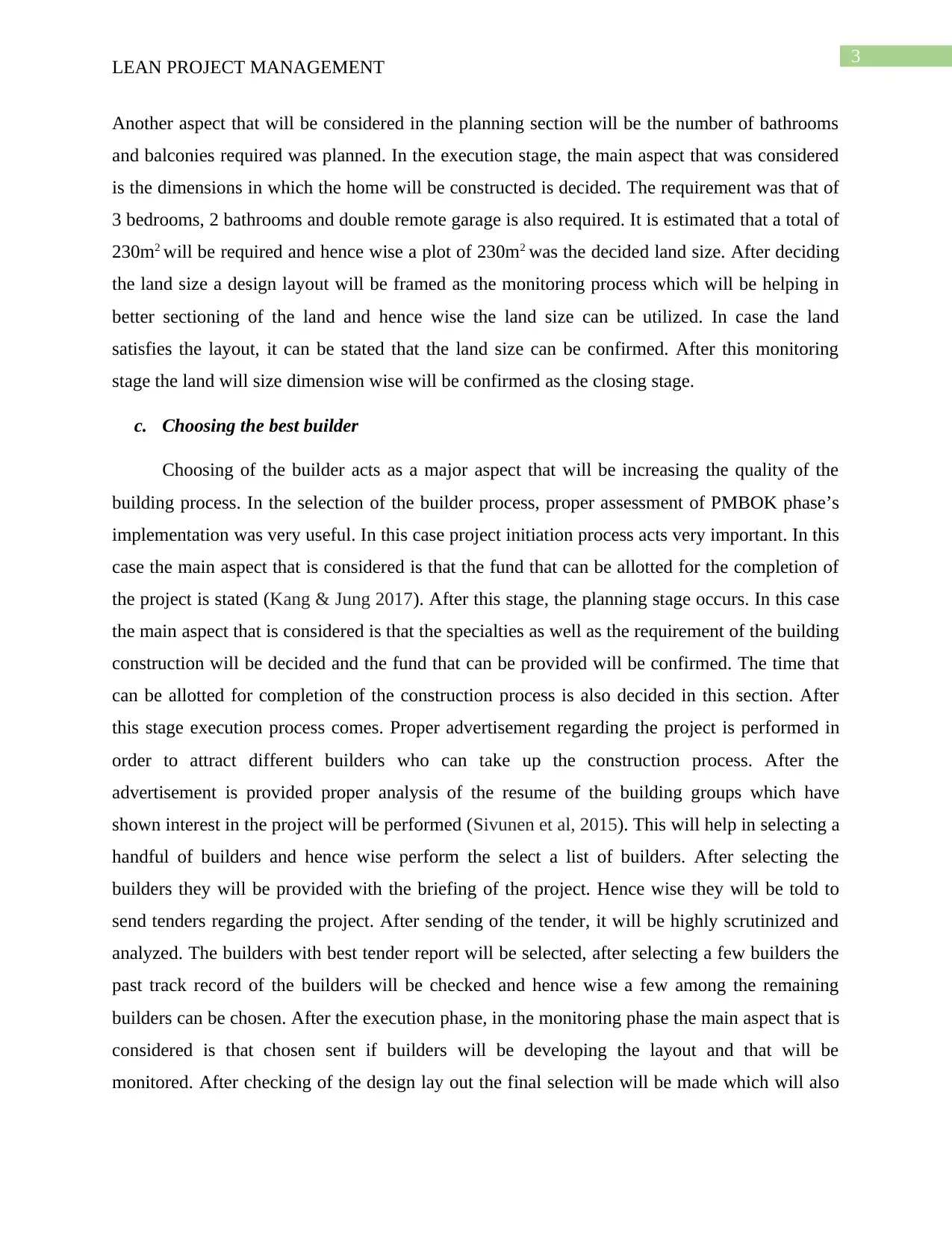
3
LEAN PROJECT MANAGEMENT
Another aspect that will be considered in the planning section will be the number of bathrooms
and balconies required was planned. In the execution stage, the main aspect that was considered
is the dimensions in which the home will be constructed is decided. The requirement was that of
3 bedrooms, 2 bathrooms and double remote garage is also required. It is estimated that a total of
230m2 will be required and hence wise a plot of 230m2 was the decided land size. After deciding
the land size a design layout will be framed as the monitoring process which will be helping in
better sectioning of the land and hence wise the land size can be utilized. In case the land
satisfies the layout, it can be stated that the land size can be confirmed. After this monitoring
stage the land will size dimension wise will be confirmed as the closing stage.
c. Choosing the best builder
Choosing of the builder acts as a major aspect that will be increasing the quality of the
building process. In the selection of the builder process, proper assessment of PMBOK phase’s
implementation was very useful. In this case project initiation process acts very important. In this
case the main aspect that is considered is that the fund that can be allotted for the completion of
the project is stated (Kang & Jung 2017). After this stage, the planning stage occurs. In this case
the main aspect that is considered is that the specialties as well as the requirement of the building
construction will be decided and the fund that can be provided will be confirmed. The time that
can be allotted for completion of the construction process is also decided in this section. After
this stage execution process comes. Proper advertisement regarding the project is performed in
order to attract different builders who can take up the construction process. After the
advertisement is provided proper analysis of the resume of the building groups which have
shown interest in the project will be performed (Sivunen et al, 2015). This will help in selecting a
handful of builders and hence wise perform the select a list of builders. After selecting the
builders they will be provided with the briefing of the project. Hence wise they will be told to
send tenders regarding the project. After sending of the tender, it will be highly scrutinized and
analyzed. The builders with best tender report will be selected, after selecting a few builders the
past track record of the builders will be checked and hence wise a few among the remaining
builders can be chosen. After the execution phase, in the monitoring phase the main aspect that is
considered is that chosen sent if builders will be developing the layout and that will be
monitored. After checking of the design lay out the final selection will be made which will also
LEAN PROJECT MANAGEMENT
Another aspect that will be considered in the planning section will be the number of bathrooms
and balconies required was planned. In the execution stage, the main aspect that was considered
is the dimensions in which the home will be constructed is decided. The requirement was that of
3 bedrooms, 2 bathrooms and double remote garage is also required. It is estimated that a total of
230m2 will be required and hence wise a plot of 230m2 was the decided land size. After deciding
the land size a design layout will be framed as the monitoring process which will be helping in
better sectioning of the land and hence wise the land size can be utilized. In case the land
satisfies the layout, it can be stated that the land size can be confirmed. After this monitoring
stage the land will size dimension wise will be confirmed as the closing stage.
c. Choosing the best builder
Choosing of the builder acts as a major aspect that will be increasing the quality of the
building process. In the selection of the builder process, proper assessment of PMBOK phase’s
implementation was very useful. In this case project initiation process acts very important. In this
case the main aspect that is considered is that the fund that can be allotted for the completion of
the project is stated (Kang & Jung 2017). After this stage, the planning stage occurs. In this case
the main aspect that is considered is that the specialties as well as the requirement of the building
construction will be decided and the fund that can be provided will be confirmed. The time that
can be allotted for completion of the construction process is also decided in this section. After
this stage execution process comes. Proper advertisement regarding the project is performed in
order to attract different builders who can take up the construction process. After the
advertisement is provided proper analysis of the resume of the building groups which have
shown interest in the project will be performed (Sivunen et al, 2015). This will help in selecting a
handful of builders and hence wise perform the select a list of builders. After selecting the
builders they will be provided with the briefing of the project. Hence wise they will be told to
send tenders regarding the project. After sending of the tender, it will be highly scrutinized and
analyzed. The builders with best tender report will be selected, after selecting a few builders the
past track record of the builders will be checked and hence wise a few among the remaining
builders can be chosen. After the execution phase, in the monitoring phase the main aspect that is
considered is that chosen sent if builders will be developing the layout and that will be
monitored. After checking of the design lay out the final selection will be made which will also
Paraphrase This Document
Need a fresh take? Get an instant paraphrase of this document with our AI Paraphraser
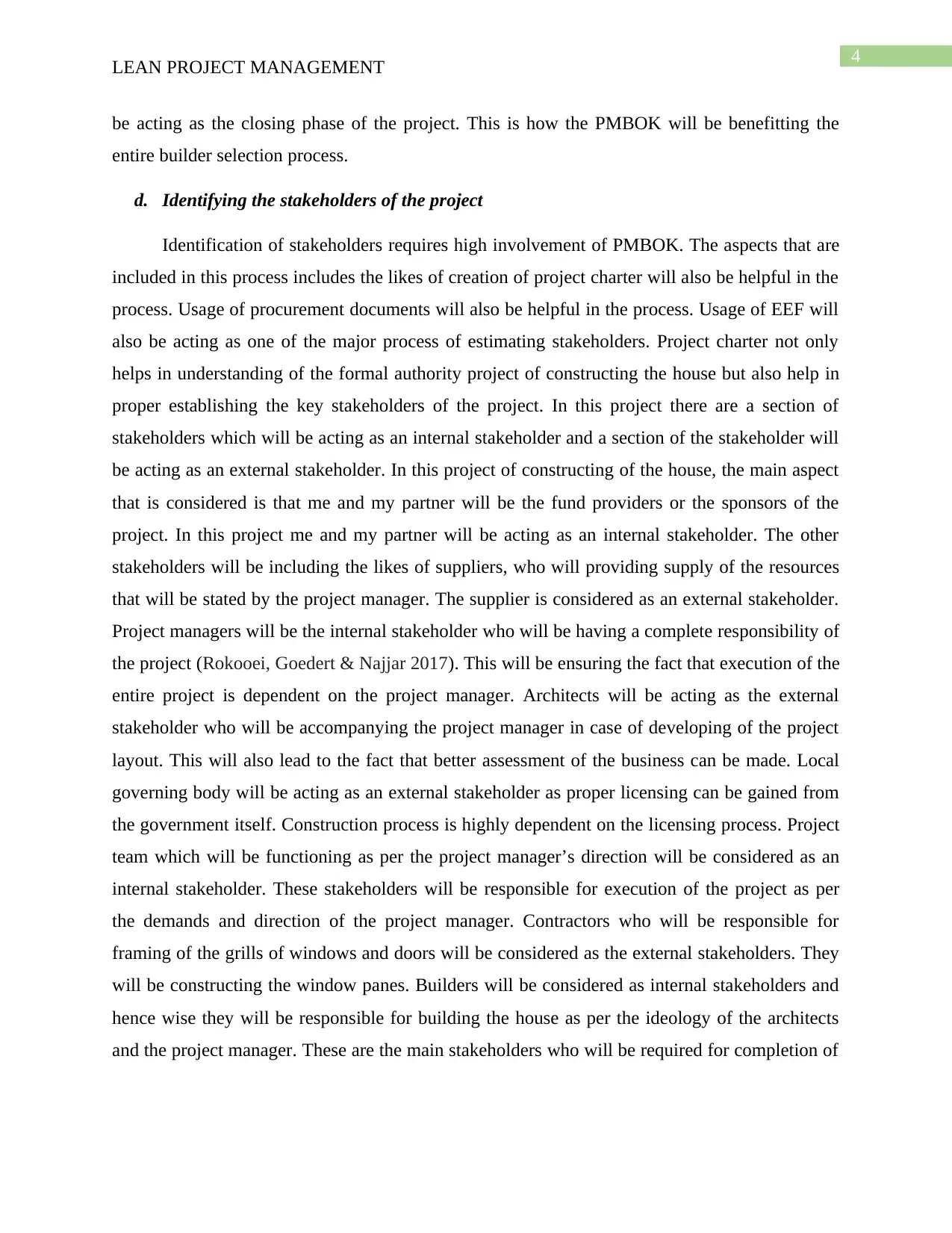
4
LEAN PROJECT MANAGEMENT
be acting as the closing phase of the project. This is how the PMBOK will be benefitting the
entire builder selection process.
d. Identifying the stakeholders of the project
Identification of stakeholders requires high involvement of PMBOK. The aspects that are
included in this process includes the likes of creation of project charter will also be helpful in the
process. Usage of procurement documents will also be helpful in the process. Usage of EEF will
also be acting as one of the major process of estimating stakeholders. Project charter not only
helps in understanding of the formal authority project of constructing the house but also help in
proper establishing the key stakeholders of the project. In this project there are a section of
stakeholders which will be acting as an internal stakeholder and a section of the stakeholder will
be acting as an external stakeholder. In this project of constructing of the house, the main aspect
that is considered is that me and my partner will be the fund providers or the sponsors of the
project. In this project me and my partner will be acting as an internal stakeholder. The other
stakeholders will be including the likes of suppliers, who will providing supply of the resources
that will be stated by the project manager. The supplier is considered as an external stakeholder.
Project managers will be the internal stakeholder who will be having a complete responsibility of
the project (Rokooei, Goedert & Najjar 2017). This will be ensuring the fact that execution of the
entire project is dependent on the project manager. Architects will be acting as the external
stakeholder who will be accompanying the project manager in case of developing of the project
layout. This will also lead to the fact that better assessment of the business can be made. Local
governing body will be acting as an external stakeholder as proper licensing can be gained from
the government itself. Construction process is highly dependent on the licensing process. Project
team which will be functioning as per the project manager’s direction will be considered as an
internal stakeholder. These stakeholders will be responsible for execution of the project as per
the demands and direction of the project manager. Contractors who will be responsible for
framing of the grills of windows and doors will be considered as the external stakeholders. They
will be constructing the window panes. Builders will be considered as internal stakeholders and
hence wise they will be responsible for building the house as per the ideology of the architects
and the project manager. These are the main stakeholders who will be required for completion of
LEAN PROJECT MANAGEMENT
be acting as the closing phase of the project. This is how the PMBOK will be benefitting the
entire builder selection process.
d. Identifying the stakeholders of the project
Identification of stakeholders requires high involvement of PMBOK. The aspects that are
included in this process includes the likes of creation of project charter will also be helpful in the
process. Usage of procurement documents will also be helpful in the process. Usage of EEF will
also be acting as one of the major process of estimating stakeholders. Project charter not only
helps in understanding of the formal authority project of constructing the house but also help in
proper establishing the key stakeholders of the project. In this project there are a section of
stakeholders which will be acting as an internal stakeholder and a section of the stakeholder will
be acting as an external stakeholder. In this project of constructing of the house, the main aspect
that is considered is that me and my partner will be the fund providers or the sponsors of the
project. In this project me and my partner will be acting as an internal stakeholder. The other
stakeholders will be including the likes of suppliers, who will providing supply of the resources
that will be stated by the project manager. The supplier is considered as an external stakeholder.
Project managers will be the internal stakeholder who will be having a complete responsibility of
the project (Rokooei, Goedert & Najjar 2017). This will be ensuring the fact that execution of the
entire project is dependent on the project manager. Architects will be acting as the external
stakeholder who will be accompanying the project manager in case of developing of the project
layout. This will also lead to the fact that better assessment of the business can be made. Local
governing body will be acting as an external stakeholder as proper licensing can be gained from
the government itself. Construction process is highly dependent on the licensing process. Project
team which will be functioning as per the project manager’s direction will be considered as an
internal stakeholder. These stakeholders will be responsible for execution of the project as per
the demands and direction of the project manager. Contractors who will be responsible for
framing of the grills of windows and doors will be considered as the external stakeholders. They
will be constructing the window panes. Builders will be considered as internal stakeholders and
hence wise they will be responsible for building the house as per the ideology of the architects
and the project manager. These are the main stakeholders who will be required for completion of
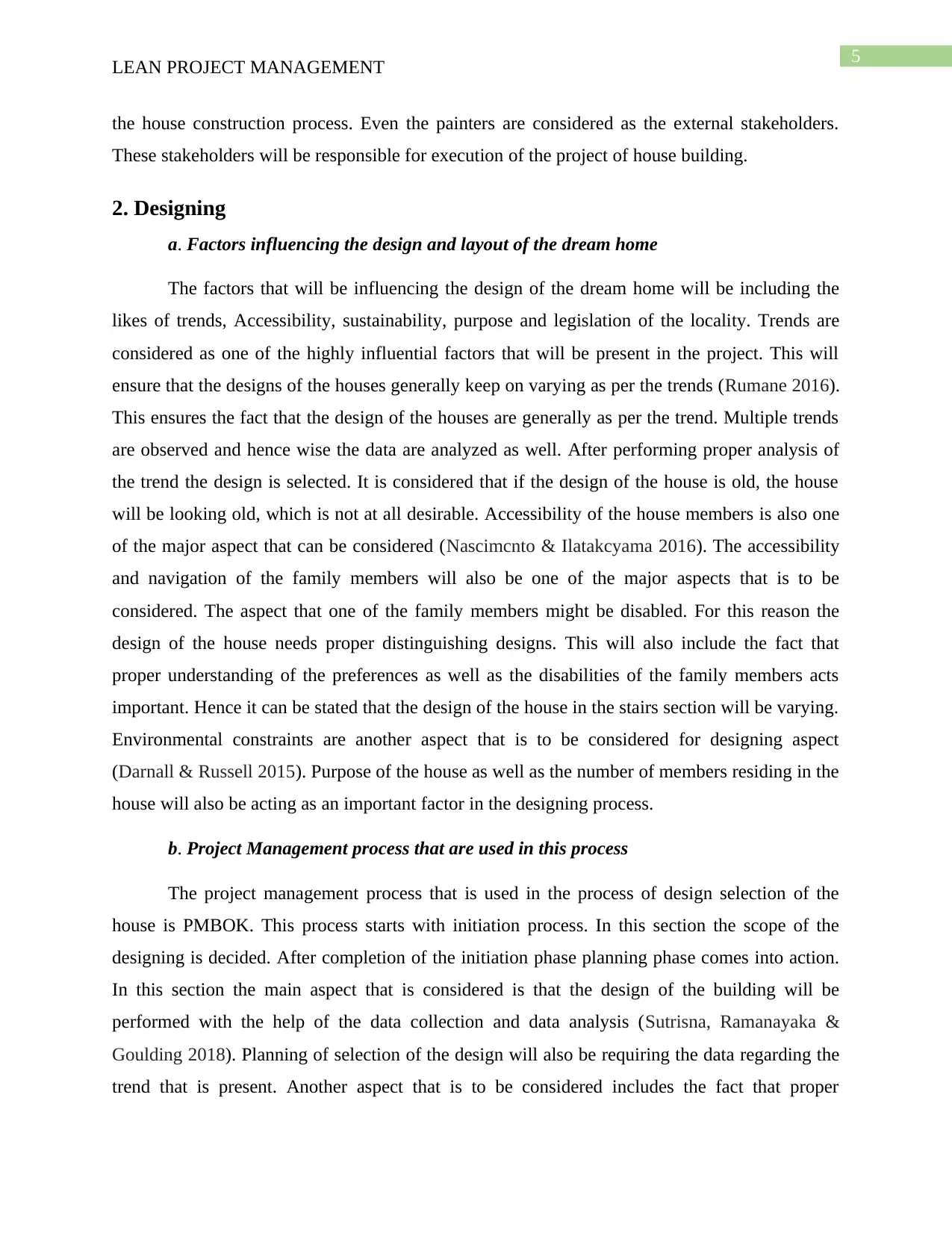
5
LEAN PROJECT MANAGEMENT
the house construction process. Even the painters are considered as the external stakeholders.
These stakeholders will be responsible for execution of the project of house building.
2. Designing
a. Factors influencing the design and layout of the dream home
The factors that will be influencing the design of the dream home will be including the
likes of trends, Accessibility, sustainability, purpose and legislation of the locality. Trends are
considered as one of the highly influential factors that will be present in the project. This will
ensure that the designs of the houses generally keep on varying as per the trends (Rumane 2016).
This ensures the fact that the design of the houses are generally as per the trend. Multiple trends
are observed and hence wise the data are analyzed as well. After performing proper analysis of
the trend the design is selected. It is considered that if the design of the house is old, the house
will be looking old, which is not at all desirable. Accessibility of the house members is also one
of the major aspect that can be considered (Nascimcnto & Ilatakcyama 2016). The accessibility
and navigation of the family members will also be one of the major aspects that is to be
considered. The aspect that one of the family members might be disabled. For this reason the
design of the house needs proper distinguishing designs. This will also include the fact that
proper understanding of the preferences as well as the disabilities of the family members acts
important. Hence it can be stated that the design of the house in the stairs section will be varying.
Environmental constraints are another aspect that is to be considered for designing aspect
(Darnall & Russell 2015). Purpose of the house as well as the number of members residing in the
house will also be acting as an important factor in the designing process.
b. Project Management process that are used in this process
The project management process that is used in the process of design selection of the
house is PMBOK. This process starts with initiation process. In this section the scope of the
designing is decided. After completion of the initiation phase planning phase comes into action.
In this section the main aspect that is considered is that the design of the building will be
performed with the help of the data collection and data analysis (Sutrisna, Ramanayaka &
Goulding 2018). Planning of selection of the design will also be requiring the data regarding the
trend that is present. Another aspect that is to be considered includes the fact that proper
LEAN PROJECT MANAGEMENT
the house construction process. Even the painters are considered as the external stakeholders.
These stakeholders will be responsible for execution of the project of house building.
2. Designing
a. Factors influencing the design and layout of the dream home
The factors that will be influencing the design of the dream home will be including the
likes of trends, Accessibility, sustainability, purpose and legislation of the locality. Trends are
considered as one of the highly influential factors that will be present in the project. This will
ensure that the designs of the houses generally keep on varying as per the trends (Rumane 2016).
This ensures the fact that the design of the houses are generally as per the trend. Multiple trends
are observed and hence wise the data are analyzed as well. After performing proper analysis of
the trend the design is selected. It is considered that if the design of the house is old, the house
will be looking old, which is not at all desirable. Accessibility of the house members is also one
of the major aspect that can be considered (Nascimcnto & Ilatakcyama 2016). The accessibility
and navigation of the family members will also be one of the major aspects that is to be
considered. The aspect that one of the family members might be disabled. For this reason the
design of the house needs proper distinguishing designs. This will also include the fact that
proper understanding of the preferences as well as the disabilities of the family members acts
important. Hence it can be stated that the design of the house in the stairs section will be varying.
Environmental constraints are another aspect that is to be considered for designing aspect
(Darnall & Russell 2015). Purpose of the house as well as the number of members residing in the
house will also be acting as an important factor in the designing process.
b. Project Management process that are used in this process
The project management process that is used in the process of design selection of the
house is PMBOK. This process starts with initiation process. In this section the scope of the
designing is decided. After completion of the initiation phase planning phase comes into action.
In this section the main aspect that is considered is that the design of the building will be
performed with the help of the data collection and data analysis (Sutrisna, Ramanayaka &
Goulding 2018). Planning of selection of the design will also be requiring the data regarding the
trend that is present. Another aspect that is to be considered includes the fact that proper
⊘ This is a preview!⊘
Do you want full access?
Subscribe today to unlock all pages.

Trusted by 1+ million students worldwide
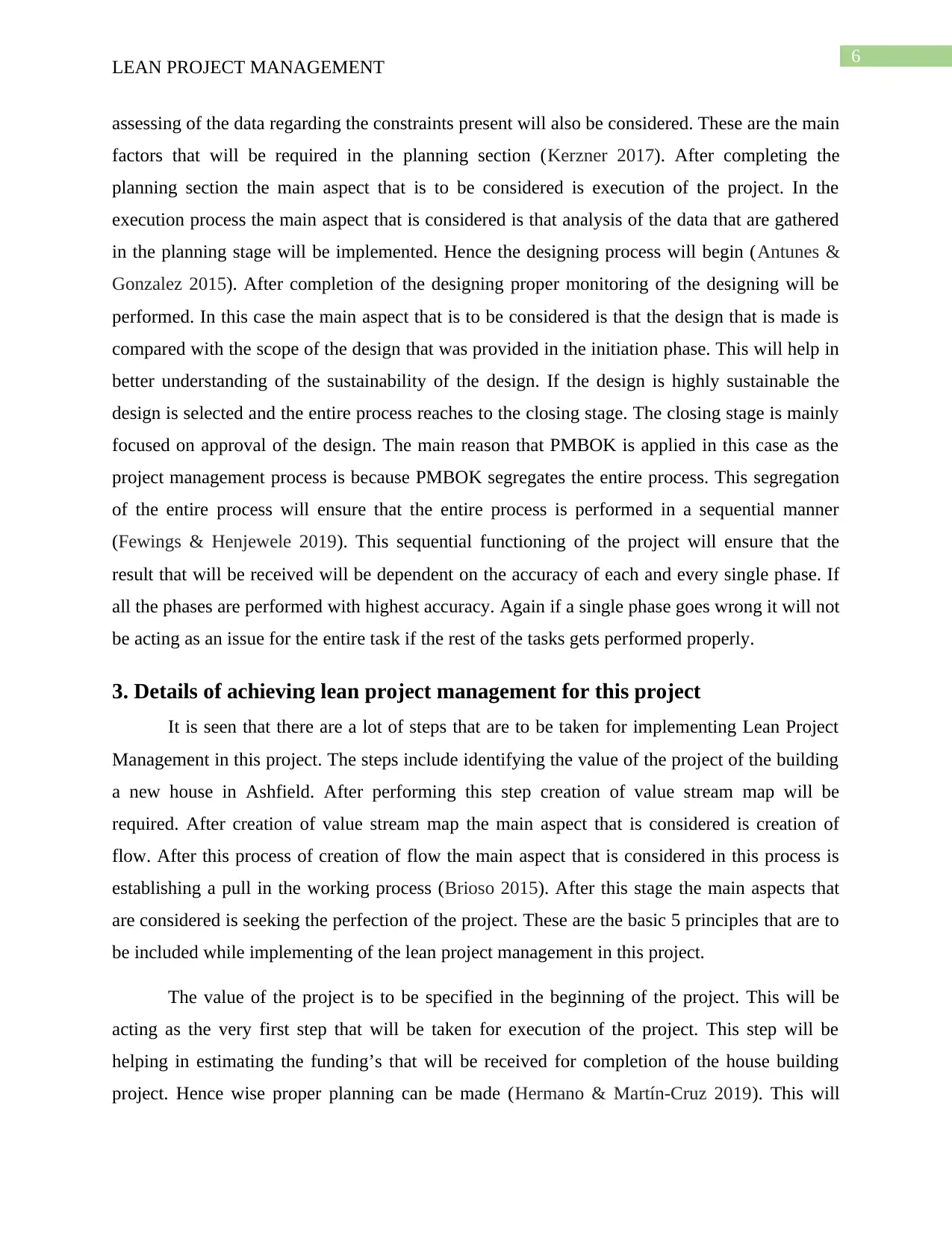
6
LEAN PROJECT MANAGEMENT
assessing of the data regarding the constraints present will also be considered. These are the main
factors that will be required in the planning section (Kerzner 2017). After completing the
planning section the main aspect that is to be considered is execution of the project. In the
execution process the main aspect that is considered is that analysis of the data that are gathered
in the planning stage will be implemented. Hence the designing process will begin (Antunes &
Gonzalez 2015). After completion of the designing proper monitoring of the designing will be
performed. In this case the main aspect that is to be considered is that the design that is made is
compared with the scope of the design that was provided in the initiation phase. This will help in
better understanding of the sustainability of the design. If the design is highly sustainable the
design is selected and the entire process reaches to the closing stage. The closing stage is mainly
focused on approval of the design. The main reason that PMBOK is applied in this case as the
project management process is because PMBOK segregates the entire process. This segregation
of the entire process will ensure that the entire process is performed in a sequential manner
(Fewings & Henjewele 2019). This sequential functioning of the project will ensure that the
result that will be received will be dependent on the accuracy of each and every single phase. If
all the phases are performed with highest accuracy. Again if a single phase goes wrong it will not
be acting as an issue for the entire task if the rest of the tasks gets performed properly.
3. Details of achieving lean project management for this project
It is seen that there are a lot of steps that are to be taken for implementing Lean Project
Management in this project. The steps include identifying the value of the project of the building
a new house in Ashfield. After performing this step creation of value stream map will be
required. After creation of value stream map the main aspect that is considered is creation of
flow. After this process of creation of flow the main aspect that is considered in this process is
establishing a pull in the working process (Brioso 2015). After this stage the main aspects that
are considered is seeking the perfection of the project. These are the basic 5 principles that are to
be included while implementing of the lean project management in this project.
The value of the project is to be specified in the beginning of the project. This will be
acting as the very first step that will be taken for execution of the project. This step will be
helping in estimating the funding’s that will be received for completion of the house building
project. Hence wise proper planning can be made (Hermano & Martín-Cruz 2019). This will
LEAN PROJECT MANAGEMENT
assessing of the data regarding the constraints present will also be considered. These are the main
factors that will be required in the planning section (Kerzner 2017). After completing the
planning section the main aspect that is to be considered is execution of the project. In the
execution process the main aspect that is considered is that analysis of the data that are gathered
in the planning stage will be implemented. Hence the designing process will begin (Antunes &
Gonzalez 2015). After completion of the designing proper monitoring of the designing will be
performed. In this case the main aspect that is to be considered is that the design that is made is
compared with the scope of the design that was provided in the initiation phase. This will help in
better understanding of the sustainability of the design. If the design is highly sustainable the
design is selected and the entire process reaches to the closing stage. The closing stage is mainly
focused on approval of the design. The main reason that PMBOK is applied in this case as the
project management process is because PMBOK segregates the entire process. This segregation
of the entire process will ensure that the entire process is performed in a sequential manner
(Fewings & Henjewele 2019). This sequential functioning of the project will ensure that the
result that will be received will be dependent on the accuracy of each and every single phase. If
all the phases are performed with highest accuracy. Again if a single phase goes wrong it will not
be acting as an issue for the entire task if the rest of the tasks gets performed properly.
3. Details of achieving lean project management for this project
It is seen that there are a lot of steps that are to be taken for implementing Lean Project
Management in this project. The steps include identifying the value of the project of the building
a new house in Ashfield. After performing this step creation of value stream map will be
required. After creation of value stream map the main aspect that is considered is creation of
flow. After this process of creation of flow the main aspect that is considered in this process is
establishing a pull in the working process (Brioso 2015). After this stage the main aspects that
are considered is seeking the perfection of the project. These are the basic 5 principles that are to
be included while implementing of the lean project management in this project.
The value of the project is to be specified in the beginning of the project. This will be
acting as the very first step that will be taken for execution of the project. This step will be
helping in estimating the funding’s that will be received for completion of the house building
project. Hence wise proper planning can be made (Hermano & Martín-Cruz 2019). This will
Paraphrase This Document
Need a fresh take? Get an instant paraphrase of this document with our AI Paraphraser
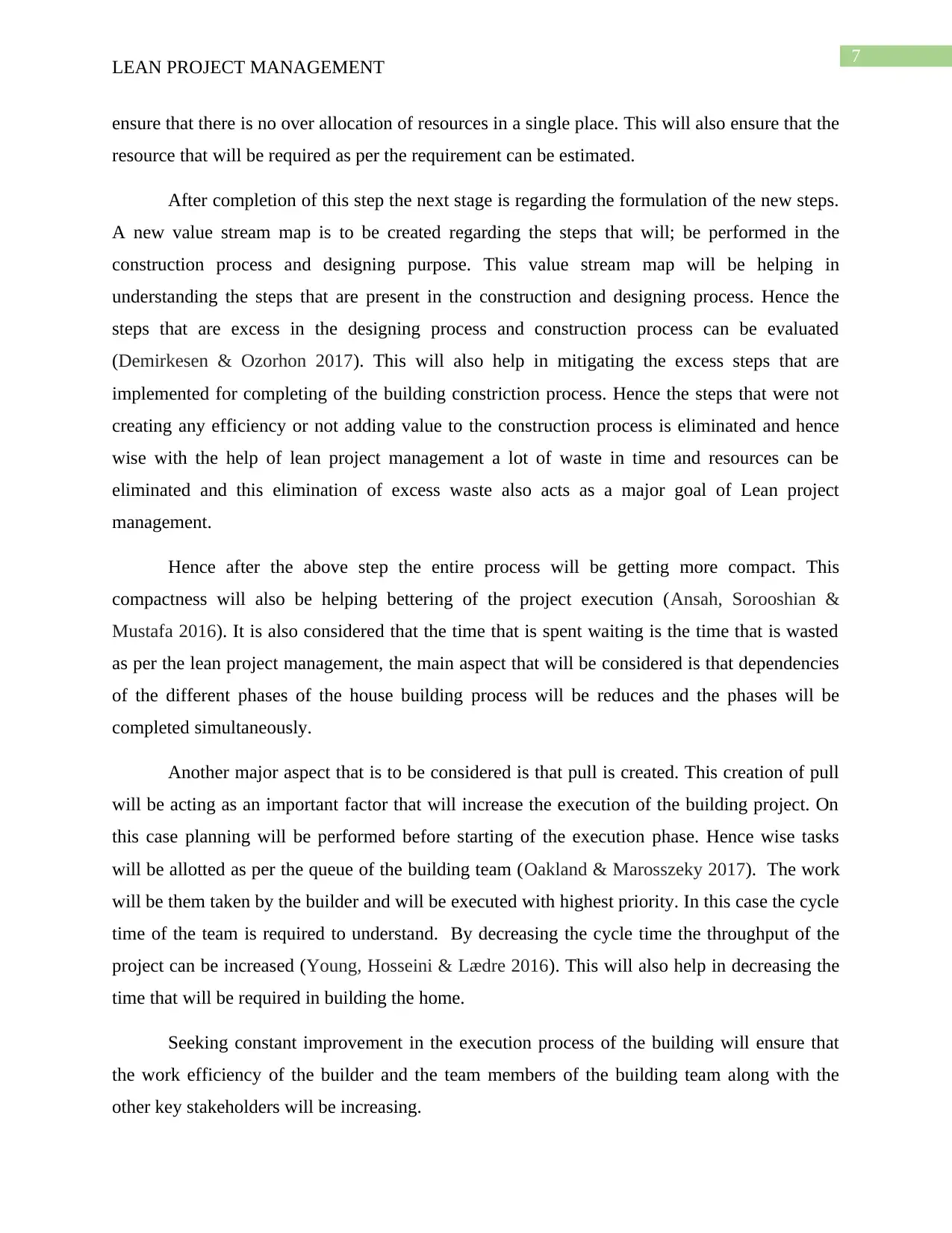
7
LEAN PROJECT MANAGEMENT
ensure that there is no over allocation of resources in a single place. This will also ensure that the
resource that will be required as per the requirement can be estimated.
After completion of this step the next stage is regarding the formulation of the new steps.
A new value stream map is to be created regarding the steps that will; be performed in the
construction process and designing purpose. This value stream map will be helping in
understanding the steps that are present in the construction and designing process. Hence the
steps that are excess in the designing process and construction process can be evaluated
(Demirkesen & Ozorhon 2017). This will also help in mitigating the excess steps that are
implemented for completing of the building constriction process. Hence the steps that were not
creating any efficiency or not adding value to the construction process is eliminated and hence
wise with the help of lean project management a lot of waste in time and resources can be
eliminated and this elimination of excess waste also acts as a major goal of Lean project
management.
Hence after the above step the entire process will be getting more compact. This
compactness will also be helping bettering of the project execution (Ansah, Sorooshian &
Mustafa 2016). It is also considered that the time that is spent waiting is the time that is wasted
as per the lean project management, the main aspect that will be considered is that dependencies
of the different phases of the house building process will be reduces and the phases will be
completed simultaneously.
Another major aspect that is to be considered is that pull is created. This creation of pull
will be acting as an important factor that will increase the execution of the building project. On
this case planning will be performed before starting of the execution phase. Hence wise tasks
will be allotted as per the queue of the building team (Oakland & Marosszeky 2017). The work
will be them taken by the builder and will be executed with highest priority. In this case the cycle
time of the team is required to understand. By decreasing the cycle time the throughput of the
project can be increased (Young, Hosseini & Lædre 2016). This will also help in decreasing the
time that will be required in building the home.
Seeking constant improvement in the execution process of the building will ensure that
the work efficiency of the builder and the team members of the building team along with the
other key stakeholders will be increasing.
LEAN PROJECT MANAGEMENT
ensure that there is no over allocation of resources in a single place. This will also ensure that the
resource that will be required as per the requirement can be estimated.
After completion of this step the next stage is regarding the formulation of the new steps.
A new value stream map is to be created regarding the steps that will; be performed in the
construction process and designing purpose. This value stream map will be helping in
understanding the steps that are present in the construction and designing process. Hence the
steps that are excess in the designing process and construction process can be evaluated
(Demirkesen & Ozorhon 2017). This will also help in mitigating the excess steps that are
implemented for completing of the building constriction process. Hence the steps that were not
creating any efficiency or not adding value to the construction process is eliminated and hence
wise with the help of lean project management a lot of waste in time and resources can be
eliminated and this elimination of excess waste also acts as a major goal of Lean project
management.
Hence after the above step the entire process will be getting more compact. This
compactness will also be helping bettering of the project execution (Ansah, Sorooshian &
Mustafa 2016). It is also considered that the time that is spent waiting is the time that is wasted
as per the lean project management, the main aspect that will be considered is that dependencies
of the different phases of the house building process will be reduces and the phases will be
completed simultaneously.
Another major aspect that is to be considered is that pull is created. This creation of pull
will be acting as an important factor that will increase the execution of the building project. On
this case planning will be performed before starting of the execution phase. Hence wise tasks
will be allotted as per the queue of the building team (Oakland & Marosszeky 2017). The work
will be them taken by the builder and will be executed with highest priority. In this case the cycle
time of the team is required to understand. By decreasing the cycle time the throughput of the
project can be increased (Young, Hosseini & Lædre 2016). This will also help in decreasing the
time that will be required in building the home.
Seeking constant improvement in the execution process of the building will ensure that
the work efficiency of the builder and the team members of the building team along with the
other key stakeholders will be increasing.
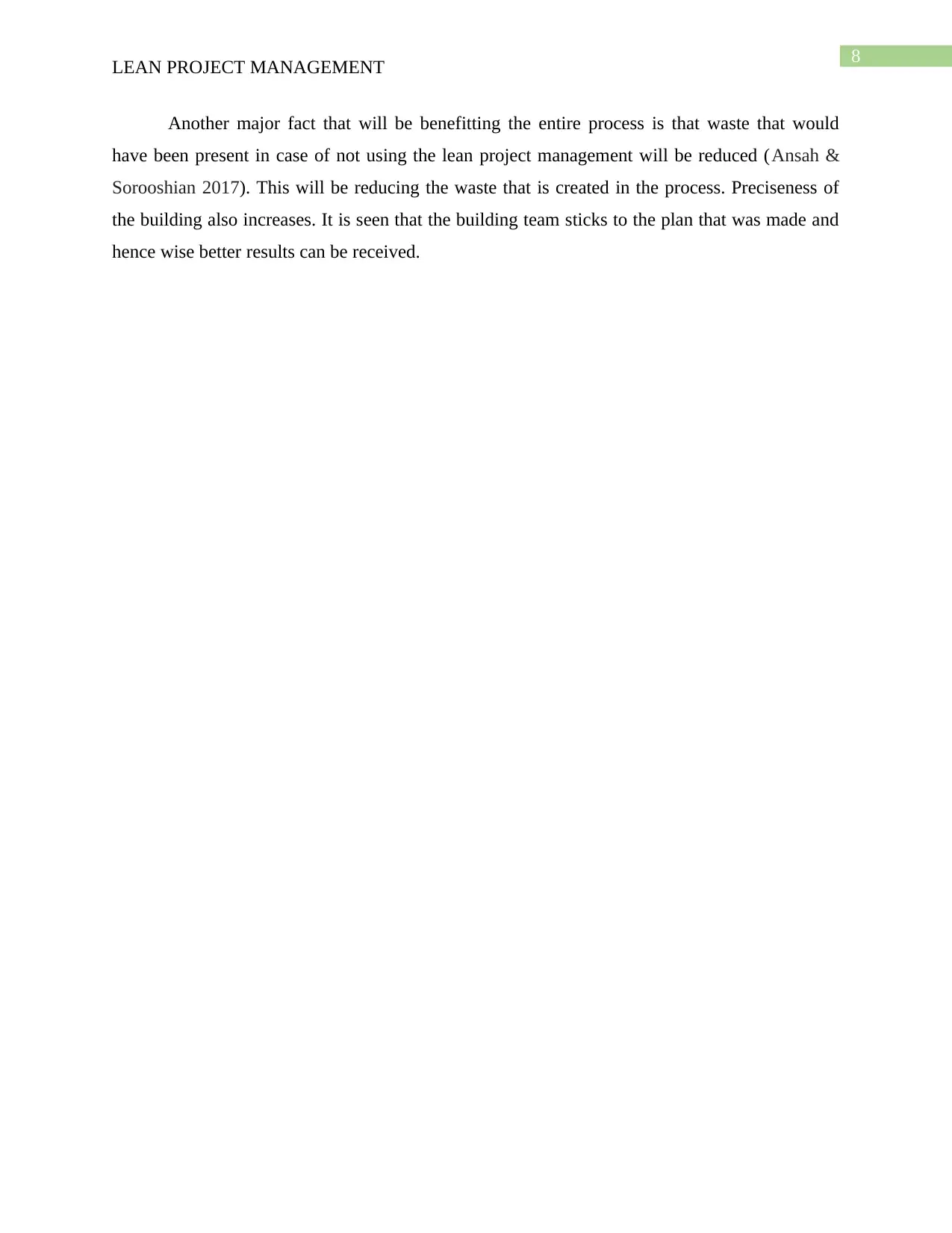
8
LEAN PROJECT MANAGEMENT
Another major fact that will be benefitting the entire process is that waste that would
have been present in case of not using the lean project management will be reduced (Ansah &
Sorooshian 2017). This will be reducing the waste that is created in the process. Preciseness of
the building also increases. It is seen that the building team sticks to the plan that was made and
hence wise better results can be received.
LEAN PROJECT MANAGEMENT
Another major fact that will be benefitting the entire process is that waste that would
have been present in case of not using the lean project management will be reduced (Ansah &
Sorooshian 2017). This will be reducing the waste that is created in the process. Preciseness of
the building also increases. It is seen that the building team sticks to the plan that was made and
hence wise better results can be received.
⊘ This is a preview!⊘
Do you want full access?
Subscribe today to unlock all pages.

Trusted by 1+ million students worldwide
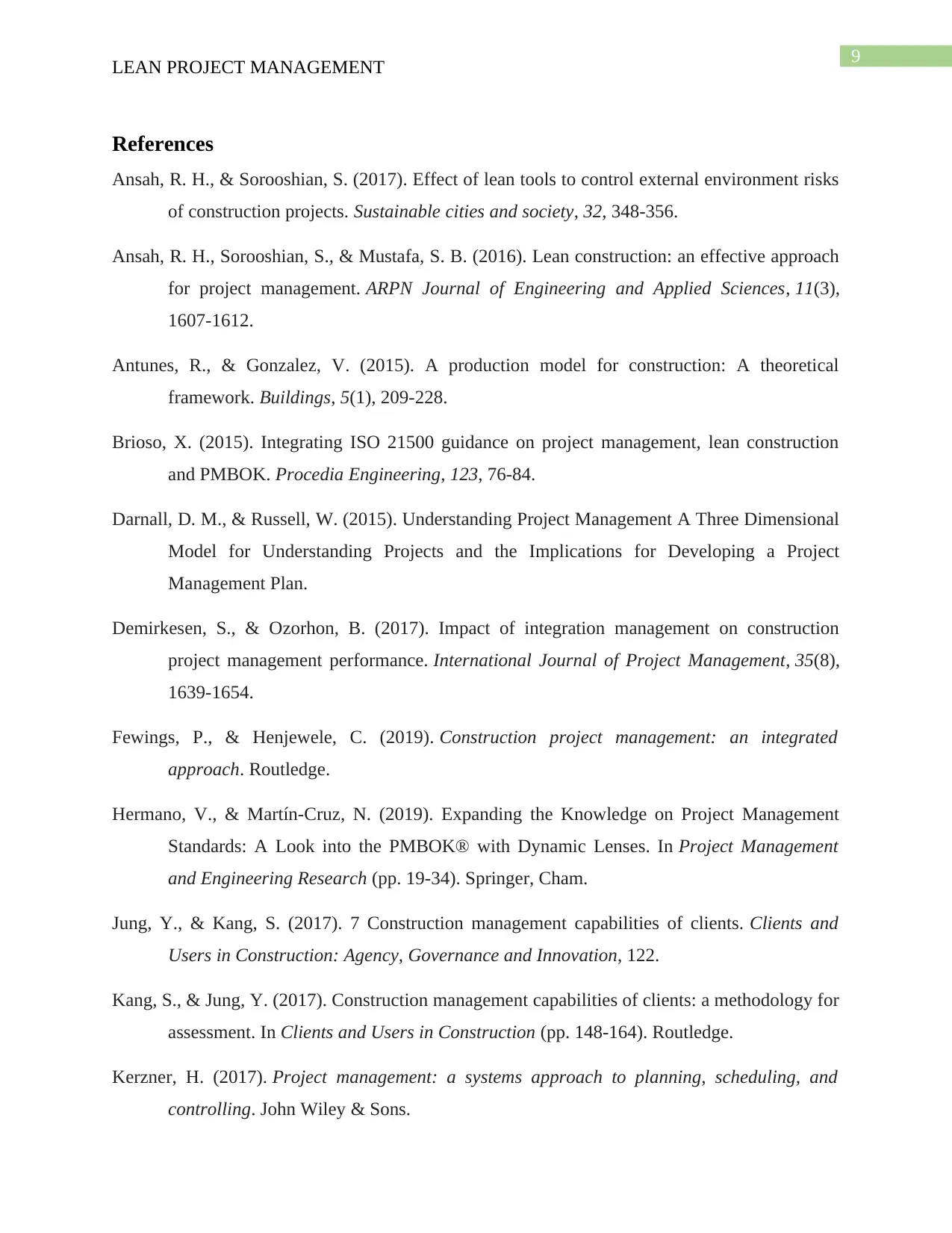
9
LEAN PROJECT MANAGEMENT
References
Ansah, R. H., & Sorooshian, S. (2017). Effect of lean tools to control external environment risks
of construction projects. Sustainable cities and society, 32, 348-356.
Ansah, R. H., Sorooshian, S., & Mustafa, S. B. (2016). Lean construction: an effective approach
for project management. ARPN Journal of Engineering and Applied Sciences, 11(3),
1607-1612.
Antunes, R., & Gonzalez, V. (2015). A production model for construction: A theoretical
framework. Buildings, 5(1), 209-228.
Brioso, X. (2015). Integrating ISO 21500 guidance on project management, lean construction
and PMBOK. Procedia Engineering, 123, 76-84.
Darnall, D. M., & Russell, W. (2015). Understanding Project Management A Three Dimensional
Model for Understanding Projects and the Implications for Developing a Project
Management Plan.
Demirkesen, S., & Ozorhon, B. (2017). Impact of integration management on construction
project management performance. International Journal of Project Management, 35(8),
1639-1654.
Fewings, P., & Henjewele, C. (2019). Construction project management: an integrated
approach. Routledge.
Hermano, V., & Martín-Cruz, N. (2019). Expanding the Knowledge on Project Management
Standards: A Look into the PMBOK® with Dynamic Lenses. In Project Management
and Engineering Research (pp. 19-34). Springer, Cham.
Jung, Y., & Kang, S. (2017). 7 Construction management capabilities of clients. Clients and
Users in Construction: Agency, Governance and Innovation, 122.
Kang, S., & Jung, Y. (2017). Construction management capabilities of clients: a methodology for
assessment. In Clients and Users in Construction (pp. 148-164). Routledge.
Kerzner, H. (2017). Project management: a systems approach to planning, scheduling, and
controlling. John Wiley & Sons.
LEAN PROJECT MANAGEMENT
References
Ansah, R. H., & Sorooshian, S. (2017). Effect of lean tools to control external environment risks
of construction projects. Sustainable cities and society, 32, 348-356.
Ansah, R. H., Sorooshian, S., & Mustafa, S. B. (2016). Lean construction: an effective approach
for project management. ARPN Journal of Engineering and Applied Sciences, 11(3),
1607-1612.
Antunes, R., & Gonzalez, V. (2015). A production model for construction: A theoretical
framework. Buildings, 5(1), 209-228.
Brioso, X. (2015). Integrating ISO 21500 guidance on project management, lean construction
and PMBOK. Procedia Engineering, 123, 76-84.
Darnall, D. M., & Russell, W. (2015). Understanding Project Management A Three Dimensional
Model for Understanding Projects and the Implications for Developing a Project
Management Plan.
Demirkesen, S., & Ozorhon, B. (2017). Impact of integration management on construction
project management performance. International Journal of Project Management, 35(8),
1639-1654.
Fewings, P., & Henjewele, C. (2019). Construction project management: an integrated
approach. Routledge.
Hermano, V., & Martín-Cruz, N. (2019). Expanding the Knowledge on Project Management
Standards: A Look into the PMBOK® with Dynamic Lenses. In Project Management
and Engineering Research (pp. 19-34). Springer, Cham.
Jung, Y., & Kang, S. (2017). 7 Construction management capabilities of clients. Clients and
Users in Construction: Agency, Governance and Innovation, 122.
Kang, S., & Jung, Y. (2017). Construction management capabilities of clients: a methodology for
assessment. In Clients and Users in Construction (pp. 148-164). Routledge.
Kerzner, H. (2017). Project management: a systems approach to planning, scheduling, and
controlling. John Wiley & Sons.
Paraphrase This Document
Need a fresh take? Get an instant paraphrase of this document with our AI Paraphraser
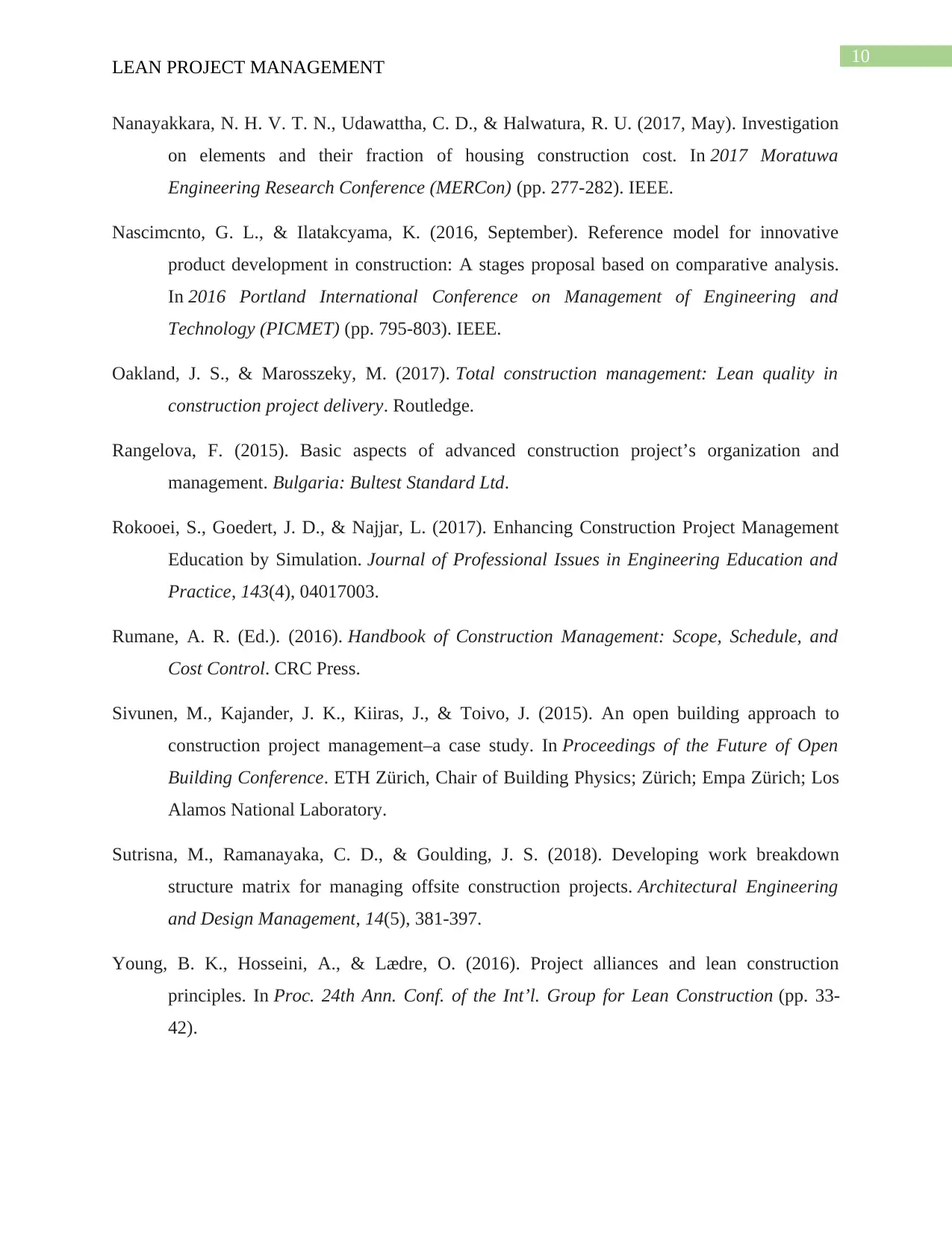
10
LEAN PROJECT MANAGEMENT
Nanayakkara, N. H. V. T. N., Udawattha, C. D., & Halwatura, R. U. (2017, May). Investigation
on elements and their fraction of housing construction cost. In 2017 Moratuwa
Engineering Research Conference (MERCon) (pp. 277-282). IEEE.
Nascimcnto, G. L., & Ilatakcyama, K. (2016, September). Reference model for innovative
product development in construction: A stages proposal based on comparative analysis.
In 2016 Portland International Conference on Management of Engineering and
Technology (PICMET) (pp. 795-803). IEEE.
Oakland, J. S., & Marosszeky, M. (2017). Total construction management: Lean quality in
construction project delivery. Routledge.
Rangelova, F. (2015). Basic aspects of advanced construction project’s organization and
management. Bulgaria: Bultest Standard Ltd.
Rokooei, S., Goedert, J. D., & Najjar, L. (2017). Enhancing Construction Project Management
Education by Simulation. Journal of Professional Issues in Engineering Education and
Practice, 143(4), 04017003.
Rumane, A. R. (Ed.). (2016). Handbook of Construction Management: Scope, Schedule, and
Cost Control. CRC Press.
Sivunen, M., Kajander, J. K., Kiiras, J., & Toivo, J. (2015). An open building approach to
construction project management–a case study. In Proceedings of the Future of Open
Building Conference. ETH Zürich, Chair of Building Physics; Zürich; Empa Zürich; Los
Alamos National Laboratory.
Sutrisna, M., Ramanayaka, C. D., & Goulding, J. S. (2018). Developing work breakdown
structure matrix for managing offsite construction projects. Architectural Engineering
and Design Management, 14(5), 381-397.
Young, B. K., Hosseini, A., & Lædre, O. (2016). Project alliances and lean construction
principles. In Proc. 24th Ann. Conf. of the Int’l. Group for Lean Construction (pp. 33-
42).
LEAN PROJECT MANAGEMENT
Nanayakkara, N. H. V. T. N., Udawattha, C. D., & Halwatura, R. U. (2017, May). Investigation
on elements and their fraction of housing construction cost. In 2017 Moratuwa
Engineering Research Conference (MERCon) (pp. 277-282). IEEE.
Nascimcnto, G. L., & Ilatakcyama, K. (2016, September). Reference model for innovative
product development in construction: A stages proposal based on comparative analysis.
In 2016 Portland International Conference on Management of Engineering and
Technology (PICMET) (pp. 795-803). IEEE.
Oakland, J. S., & Marosszeky, M. (2017). Total construction management: Lean quality in
construction project delivery. Routledge.
Rangelova, F. (2015). Basic aspects of advanced construction project’s organization and
management. Bulgaria: Bultest Standard Ltd.
Rokooei, S., Goedert, J. D., & Najjar, L. (2017). Enhancing Construction Project Management
Education by Simulation. Journal of Professional Issues in Engineering Education and
Practice, 143(4), 04017003.
Rumane, A. R. (Ed.). (2016). Handbook of Construction Management: Scope, Schedule, and
Cost Control. CRC Press.
Sivunen, M., Kajander, J. K., Kiiras, J., & Toivo, J. (2015). An open building approach to
construction project management–a case study. In Proceedings of the Future of Open
Building Conference. ETH Zürich, Chair of Building Physics; Zürich; Empa Zürich; Los
Alamos National Laboratory.
Sutrisna, M., Ramanayaka, C. D., & Goulding, J. S. (2018). Developing work breakdown
structure matrix for managing offsite construction projects. Architectural Engineering
and Design Management, 14(5), 381-397.
Young, B. K., Hosseini, A., & Lædre, O. (2016). Project alliances and lean construction
principles. In Proc. 24th Ann. Conf. of the Int’l. Group for Lean Construction (pp. 33-
42).
1 out of 11
Related Documents
Your All-in-One AI-Powered Toolkit for Academic Success.
+13062052269
info@desklib.com
Available 24*7 on WhatsApp / Email
![[object Object]](/_next/static/media/star-bottom.7253800d.svg)
Unlock your academic potential
Copyright © 2020–2025 A2Z Services. All Rights Reserved. Developed and managed by ZUCOL.




